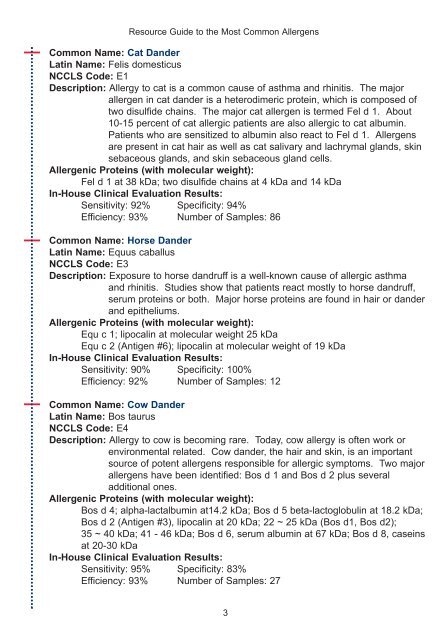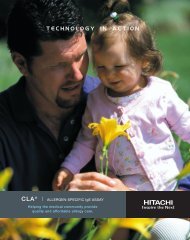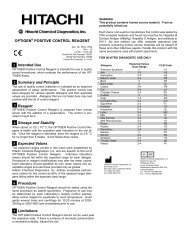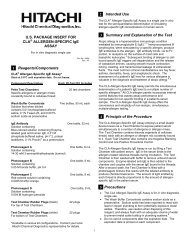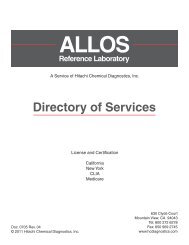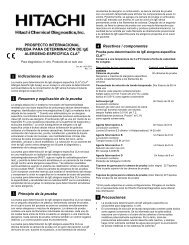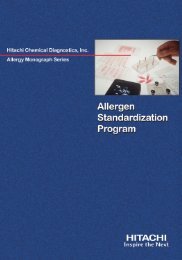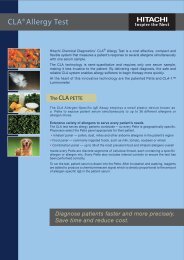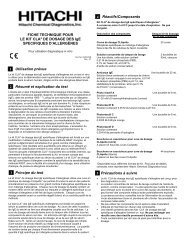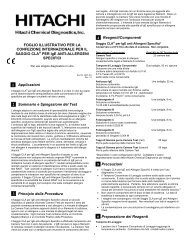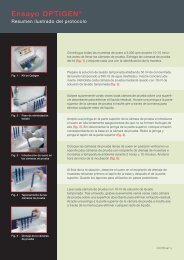Allergen Resource Guide - Hitachi Chemical Diagnostics
Allergen Resource Guide - Hitachi Chemical Diagnostics
Allergen Resource Guide - Hitachi Chemical Diagnostics
Create successful ePaper yourself
Turn your PDF publications into a flip-book with our unique Google optimized e-Paper software.
<strong>Resource</strong> <strong>Guide</strong> to the Most Common <strong>Allergen</strong>s<br />
Common Name: Cat Dander<br />
Latin Name: Felis domesticus<br />
NCCLS Code: E1<br />
Description: Allergy to cat is a common cause of asthma and rhinitis. The major<br />
allergen in cat dander is a heterodimeric protein, which is composed of<br />
two disulfide chains. The major cat allergen is termed Fel d 1. About<br />
10-15 percent of cat allergic patients are also allergic to cat albumin.<br />
Patients who are sensitized to albumin also react to Fel d 1. <strong>Allergen</strong>s<br />
are present in cat hair as well as cat salivary and lachrymal glands, skin<br />
sebaceous glands, and skin sebaceous gland cells.<br />
<strong>Allergen</strong>ic Proteins (with molecular weight):<br />
Fel d 1 at 38 kDa; two disulfide chains at 4 kDa and 14 kDa<br />
In-House Clinical Evaluation Results:<br />
Sensitivity: 92% Specificity: 94%<br />
Efficiency: 93% Number of Samples: 86<br />
Common Name: Horse Dander<br />
Latin Name: Equus caballus<br />
NCCLS Code: E3<br />
Description: Exposure to horse dandruff is a well-known cause of allergic asthma<br />
and rhinitis. Studies show that patients react mostly to horse dandruff,<br />
serum proteins or both. Major horse proteins are found in hair or dander<br />
and epitheliums.<br />
<strong>Allergen</strong>ic Proteins (with molecular weight):<br />
Equ c 1; lipocalin at molecular weight 25 kDa<br />
Equ c 2 (Antigen #6); lipocalin at molecular weight of 19 kDa<br />
In-House Clinical Evaluation Results:<br />
Sensitivity: 90% Specificity: 100%<br />
Efficiency: 92% Number of Samples: 12<br />
Common Name: Cow Dander<br />
Latin Name: Bos taurus<br />
NCCLS Code: E4<br />
Description: Allergy to cow is becoming rare. Today, cow allergy is often work or<br />
environmental related. Cow dander, the hair and skin, is an important<br />
source of potent allergens responsible for allergic symptoms. Two major<br />
allergens have been identified: Bos d 1 and Bos d 2 plus several<br />
additional ones.<br />
<strong>Allergen</strong>ic Proteins (with molecular weight):<br />
Bos d 4; alpha-lactalbumin at14.2 kDa; Bos d 5 beta-lactoglobulin at 18.2 kDa;<br />
Bos d 2 (Antigen #3), lipocalin at 20 kDa; 22 ~ 25 kDa (Bos d1, Bos d2);<br />
35 ~ 40 kDa; 41 - 46 kDa; Bos d 6, serum albumin at 67 kDa; Bos d 8, caseins<br />
at 20-30 kDa<br />
In-House Clinical Evaluation Results:<br />
Sensitivity: 95% Specificity: 83%<br />
Efficiency: 93% Number of Samples: 27<br />
3


